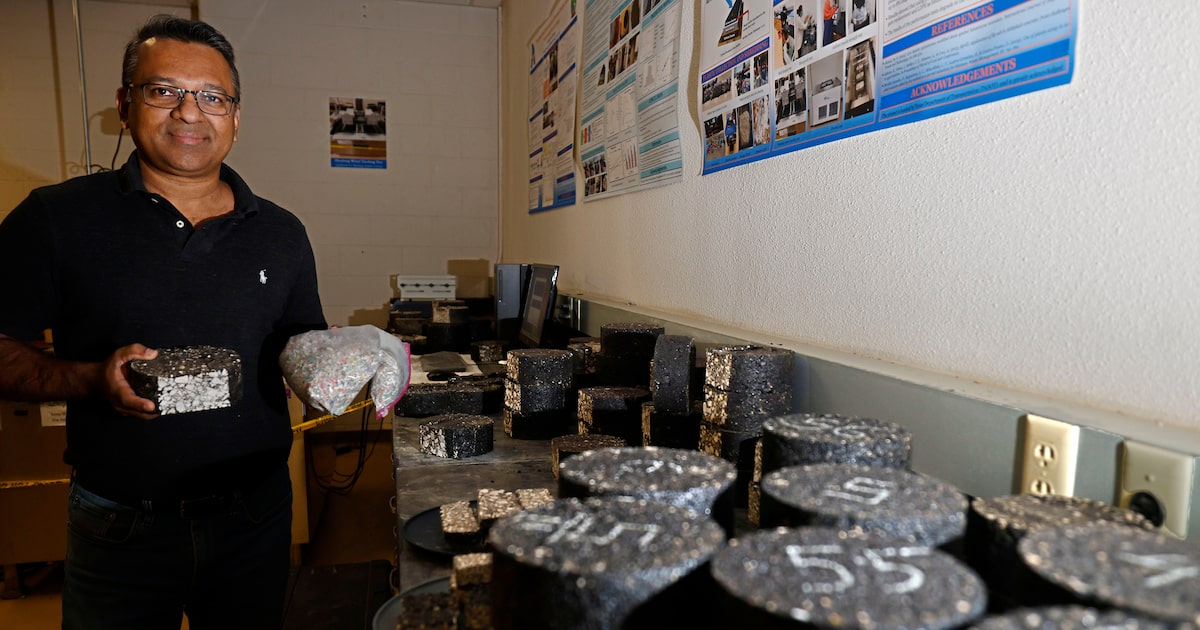Drive anywhere in Dallas and it’s hard to miss hitting a pothole. Whether a small divot or a crater shutting down two highway lanes, potholes epitomize a recurring theme of North Texas roads: the constant flux between repair and disrepair.
But at the University of Texas at Arlington, civil engineer Sahadat Hossain is working on a solution he says can make roads stronger and more durable, all thanks to one key ingredient: recycled plastic. He’s used this material in stretches of pavement in two parking lots at the school and, with nearly $1 million in state funding, he is testing “plastic roads” in the Dallas-Fort Worth area.
Improving roadway infrastructure is an important effort in the Lone Star State. Around 48% of roads were in poor or fair condition and around 1.2% of bridges were “structurally deficient” in Texas in 2024, according to a 2025 report from the American Society of Civil Engineers. Each year, state motorists pay on average $948 due to driving on roads in need of repair and lose a little over $1,420 due to car crashes, the report added.
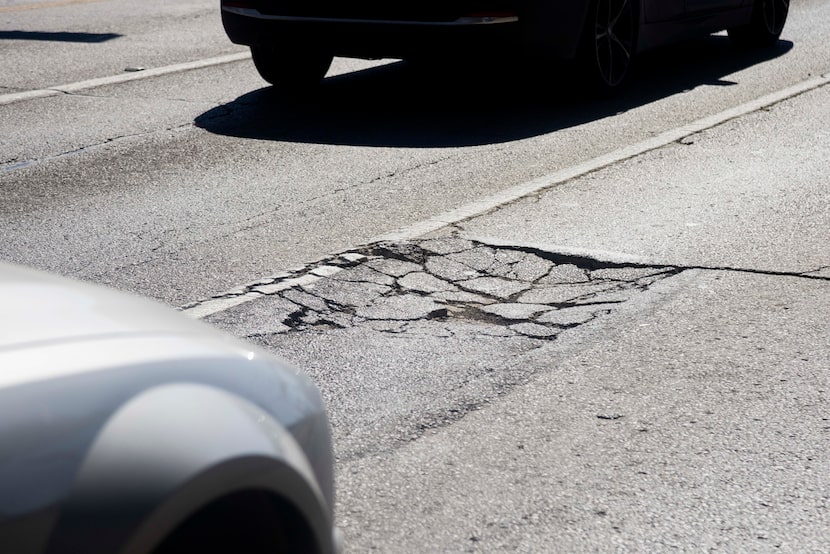
A pothole on Ross Avenue photographed on Feb. 21, 2024, in Dallas.
Juan Figueroa / Staff Photographer
Breaking News
Road damage in Texas, Hossain said, is partly caused by extreme heat and torrential rain, both of which are exacerbated by climate change.
By adding plastic to asphalt, Texas roads could become climate adaptive, tolerant of the state’s increasingly severe weather while lasting longer than traditional pavement, Hossain said.
The use of plastic roads has its supporters, but some question whether the use of recycled plastic is ultimately good for the environment. And while there is optimism about the durability of plastic roads, it is tempered by limited data.
Why plastic?
Plastic roads aren’t a new idea. They were first introduced two decades ago in India and have since been used in countries around the world. They are now being tested in the U.S., including in Missouri, California and Hawaii.
While strengthening roads is a welcome bonus, the real aim — at least for Hossain — is to combat the problem of plastic pollution, turning everyday waste into something durable and useful.
Four hundred million tons of plastic waste — from single-use bags to plastic cutlery and food containers — are produced worldwide each year, with a little over 13% by the United States in 2016, according to some estimates. A 2025 study published in the journal Communications Earth & Environment found only 9.5% of the 400 million tons of new plastic in 2022 was produced from recycled materials. A 2022 report from the National Renewable Energy Laboratory found in the U.S. in 2019, only 5% of plastic waste was recycled and 86% was landfilled.
Finding sustainable solutions to waste issues has been on Hossain’s mind for nearly the last three decades.
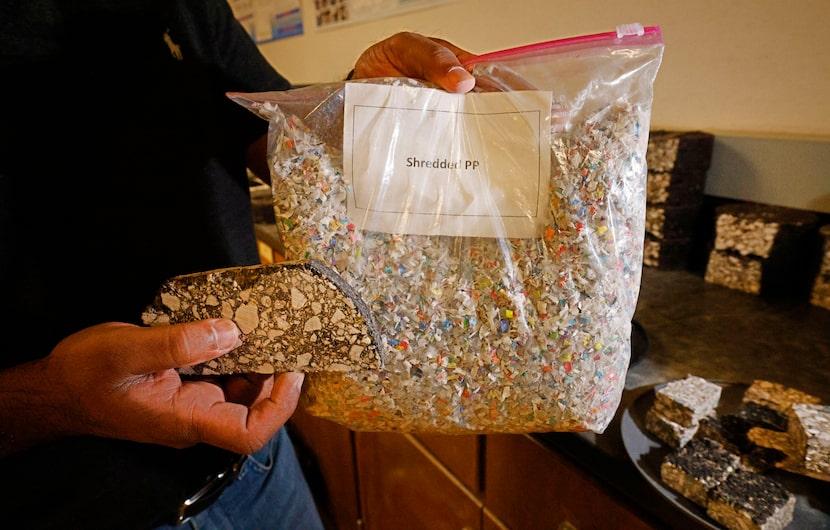
Sahadat Hossain, a civil engineering professor at the University of Texas at Arlington, shows a sample of recycled plastic in asphalt and a bag of recycled plastic used to make the asphalt, May 1, 2024, at a laboratory at the university.
Chitose Suzuki / Staff Photographer
Growing up in Bangladesh’s capital of Dhaka, Hossain witnessed the harmful effects urban pollution and poor waste management had on the people living near encroaching tides of garbage. This experience guided him toward pondering ways to mitigate landfills and dumpsites when studying for his civil engineering degree in India.
“[Waste] was something that bugged me, [and] had me wondering if there was any way to make things better,” said Hossain, 54.
His first foray into repurposing plastic waste was in 2010, when he created recycled plastic pins to shore up highway slopes in North Texas and keep them from eroding. These 8- to 12-foot long pins, inserted into the soil much like a nail into a block of wood, were installed in highways including U.S. 287, State Highway 183 and Interstate 35.
“There was a lot of reluctance about whether [the project] was going to work or not,” Hossain said. “We fixed 25 slopes and every one of them is still holding up.”
Some early promise
In Hossain’s lab at UT Arlington, he and his team of graduate students and other researchers spent the last few years experimenting with different kinds of plastic and asphalt mixtures. The lab is filled with long rectangular cuts and round cakes from their efforts. There’s equipment to test how much force the material can withstand, tubs to submerge it in water and a machine called a Hamburg Wheel Tester where a metal wheel rolls on the material’s surface to evaluate how well it can resist rutting, or deformation.
A plastic road is tricky to make. Plastic and bitumen — the black sticky residue left over from crude oil processing that holds asphalt together — don’t mix well because of their different melting points.
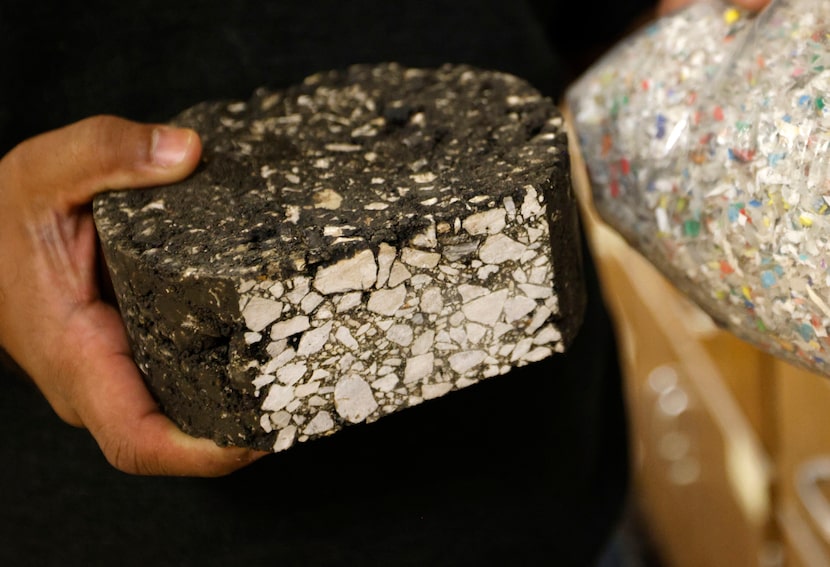
Sahadat Hossain, a civil engineering professor at the University of Texas at Arlington, shows a sample of recycled plastic in asphalt and a bag of recycled plastic used to make the asphalt, May 1, 2024, at a laboratory at the university.
Chitose Suzuki / Staff Photographer
The researchers discovered the trick was to mix plastic with aggregate, or the bits of rock, sand and gravel usually in asphalt. The aggregate is heated, then plastic is mixed in. When the mixture is cooled, it’s covered in bitumen, a liquid that acts like glue. The final product resembles something like a super-hard granola bar. Hossain said the final product is tougher than regular asphalt and appears to resist water or mechanical damage, at least according to test results that have yet to be published.
In the structural tests he and his colleagues did in the lab, the plastic road performed better than traditional asphalt did, Hossain said. “It reduces the pothole, it reduces the crack, it increases the life of the pavement.”
The stretches of plastic road in the UT Arlington parking lots are expected to last longer than traditional asphalt, said Greg Hladik, the university’s executive director of auxiliary services.
“Those parking lots are really unique because we have asphalt that’s a year older right next to the plastic asphalt,” Hladik said. “What we’re anticipating is that the plastic parking lots will be degrading at half the speed of the nonplastic asphalt.”
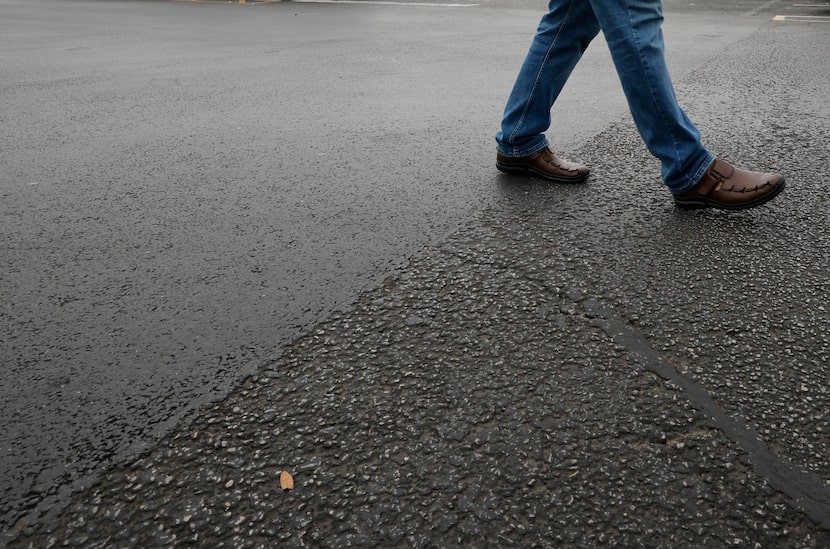
Sahadat Hossain, a civil engineering professor at the University of Texas at Arlington, steps over the border of the asphalt pavement formulated with recycled plastic, left, and the regular asphalt pavement, May 1, 2024, in a parking lot at the university.
Chitose Suzuki / Staff Photographer
Another proof-of-concept plastic road was constructed in Dhaka by Hossain in collaboration with Bangladesh’s Roads and Highways Department in September 2023. This road didn’t degrade during the country’s heatwave in April 2024 when temperatures reached triple digits. Hossain said the addition of recycled plastic ups the pavement’s melting point from around 160 degrees Fahrenheit to as much as 180 degrees Fahrenheit, at least according to studies in his lab. Even during Texas’ extreme heat two summers ago when the parking lots were installed, the plastic road didn’t deteriorate.
“So in both [Texas and Bangladesh], it’s resisting the heat,” Hossain said. “That means the plastic road is becoming climate adaptive.”
Environmental concerns
The project comes with one major concern: the risk of recycled plastic leaching harmful chemicals or introducing microplastics into the environment.
Bill Buttlar, the director of the University of Missouri’s Asphalt Pavement and Innovation Lab, said the risk of microplastics and chemicals leaching into the surrounding environment appears to be low. He and his colleagues have been researching ways to make roads more sustainable and resilient using recycled plastic and other materials such as ground tire rubber. Over the last few years, Buttlar has been working with the Missouri Department of Transportation to assess plastic roads, which included installing them in portions of state highways.
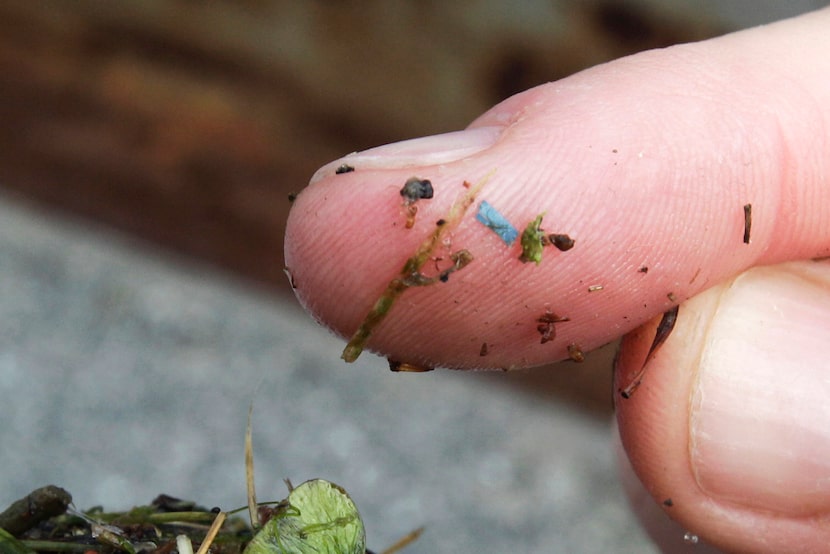
A blue rectangular piece of microplastic sits on the finger of a researcher with the University of Washington-Tacoma environmental science program, after it was found in debris collected from the Thea Foss Waterway, in Tacoma, Wash., on May 19, 2010.
Ted S. Warren / AP
In a 2024 study published in the journal Resources, Conservation and Recycling, Buttlar and his colleagues found the release of microplastics from recycled plastic-asphalt was estimated to be a thousand times less than rubber particles released from worn tires. (Hossain said in his lab’s experiments where the recycled plastic-asphalt was exposed, microplastic release was very minimal.)
“Plastic itself becomes entombed in asphalt, which is a waterproofing material,” Buttlar said. “So it makes it pretty hard for that to leak out.”
The makeup of a plastic road may depend on location. In Texas, plastic roads would need to withstand hotter temperatures and wetter weather, whereas in chilly northern states such as in the Midwest, they need to resist cracking under cold temperatures. (Hossain said his lab is testing to see how its plastic road would fare under colder weather conditions in a place such as Amarillo.)
“I think a lot of our pavement solutions are region specific. There will be similar approaches taken with just slightly different nuances to the physical properties,” Buttlar said. “Fortunately, we’ve shown that, at least in waste plastic and also ground tire rubber and asphalt, you can create tailored solutions for all these different environments. That’s the good news.”
Some researchers take a different view of the potential environmental impact of plastic roads. Imad Al-Qadi, director of the Illinois Center for Transportation at the University of Illinois Urbana-Champaign, noted there’s no long-term data showing whether plastic-modified asphalt produces fewer greenhouse gas emissions than traditional pavement.
In 2024, he co-authored a report that outlines current research, key challenges and next steps for using waste plastics in road construction.
Sometimes, he said, recycling can produce more emissions than if the plastic waste is reused elsewhere. He added that if combining plastic with asphalt results in higher overall emissions and doesn’t significantly improve the pavement’s durability, lifespan or resilience, the environmental payoff of recycling may not be worth it. Arriving at definitive answers, he said, would require years of real-world testing.
Hossain said his lab is doing some of that testing now. While results are pending, he believes their approach — using cleaned and shredded plastic waste rather than melting it down into pellets — avoids an emissions-heavy step in production. That, he hopes, could make a meaningful difference in the pavement’s overall climate footprint.
The future of plastic roads in North Texas
Hossain has collaborated with the Texas Department of Transportation to test out plastic roads in North Texas. The agency previously awarded him a $950,000 grant for his research in 2023. In May of this year, Hossain worked with TxDOT to construct a nearly mile-long length of road in Rockwall on State Highway 205. So far, the stretch of highway is holding up, but Hossain and TxDOT plan to check its strength and durability periodically over the next several years.
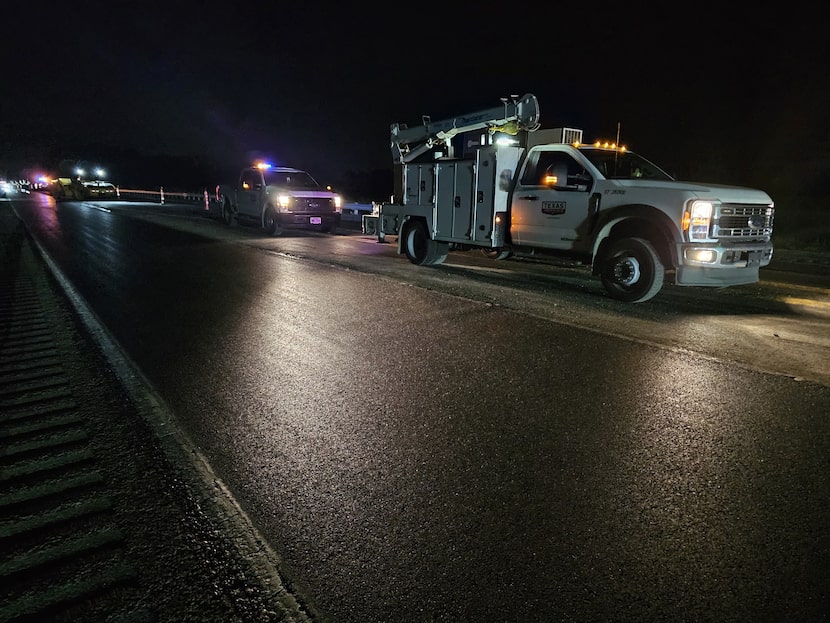
In May of this year, Hossain worked with the Texas Department of Transportation to construct a nearly mile-long length of plastic road in Rockwall of State Highway 205.
UT Arlington
Hossain, Hladik and Buttlar agree that paving roads with recycled plastic will save money on maintenance. More importantly, they say, it will introduce a circular economy: a closed loop whereby plastic materials are recovered and reused.
“This is a great example of the kind of sustainable infrastructure project Dr. Hossain and TxDOT are collaborating on — one that can really make an impact on the future and drive a more sustainable future,” said Brian R. Barth, deputy executive director at TxDOT, in a news release from UT Arlington.
Not everyone is convinced plastic roads are a sustainable fix in Texas. Ian Seamans, Dallas City Hall advocate for the nonprofit advocacy group Environment Texas, said the effort may offer a feel-good solution without tackling the root of the problem: the production and consumption of plastic.
“Putting plastic into a road is not really a solution. It is ‘greenwashing,’ ” said Seamans, using a term that means promoting a solution as green or sustainable when it doesn’t meaningfully reduce environmental harm. “Oil industry-backed groups have been promulgating a lot of these ‘solutions’ for a number of years, and the commonality between all these solutions is that they are typically low scale; they are not meeting the size of our problem.
“They are often a way of making people feel better about plastic use and take away energy from actual, real policy solutions,” Seamans added.
Al-Qadi echoed Seamans’ skepticism, stressing that even if plastic roads prove durable and to have low greenhouse gas emissions, they’re unlikely to make a significant dent in the plastic waste crisis. Only a small fraction of the plastic waste generated — around 2%, Al-Qadi said — is suitable for use in pavement, limiting the overall impact of this approach.
“Honestly, I’m not expecting all roads in the U.S. to use [plastic-modified asphalt],” he said. Even if implemented in 5% of U.S. roads, he added, “you’re talking about like 0.1% of produced plastic waste [used]. That’s a very, very small amount.”
Hossain doesn’t pretend plastic roads are a silver bullet. He knows they won’t tip the scale on plastic waste and understands the criticism that plastic roads might send the wrong message about continued plastic use, which he doesn’t support. The real goal, he said, isn’t just recycling; it’s about engineering a pavement that can hopefully last longer and perform better. In a world with few good options for managing plastic waste, Hossain views this as a step worth taking.
“The main message is we are taking one problem to solve another,” he said. “This is a perfect example of a sustainable solution.”
Miriam Fauzia is a science reporting fellow at The Dallas Morning News. Her fellowship is supported by the University of Texas at Dallas. The News makes all editorial decisions.
